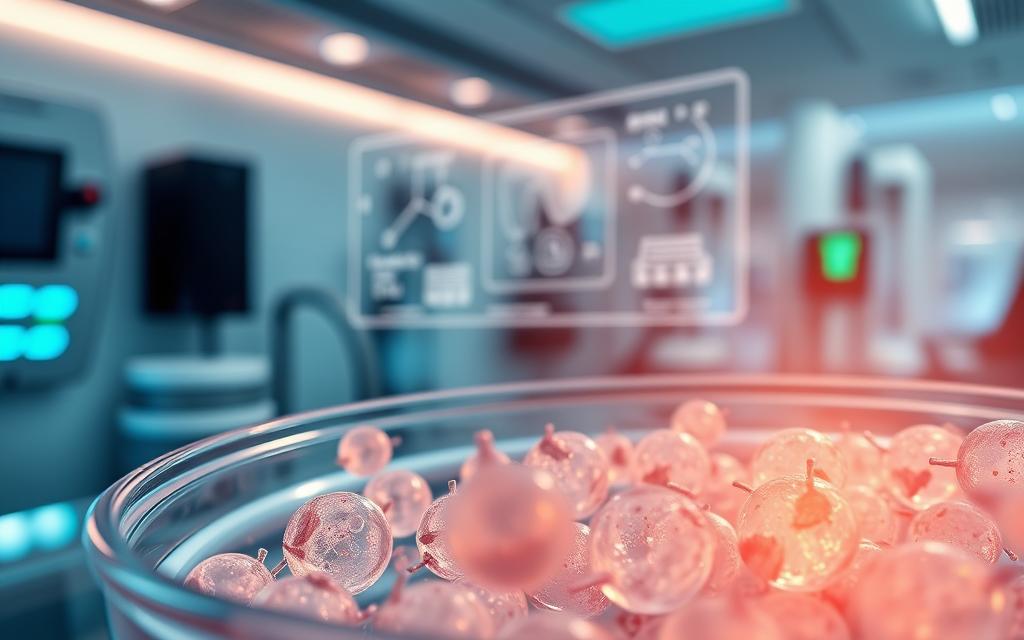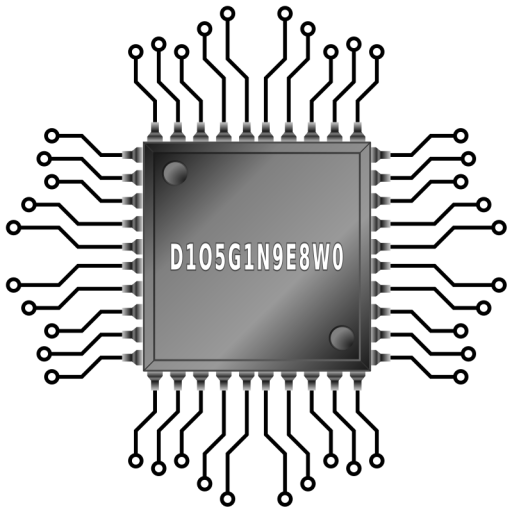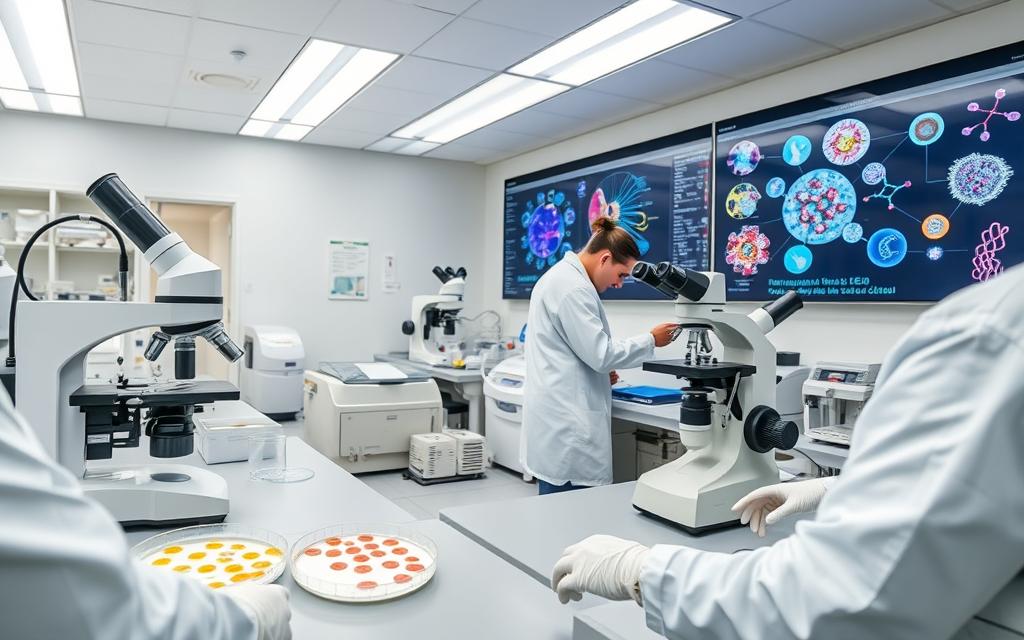Imagine a world where damaged organs heal themselves and chronic diseases are treatable. This dream is driving regenerative medicine, a field changing healthcare with special biological tools. At its heart is stem cell technology, using cells that can grow into different tissue types.
Institutions like the Mayo Clinic see their power to “change how we treat” diseases from heart issues to spinal injuries.
Recent breakthroughs have turned theory into real treatments. Scientists use these cells to grow cartilage, fix vision, and fight neurodegenerative diseases. Clinical trials show they can rebuild damaged tissues, giving hope where old methods fail.
Experts think this could make us less reliant on organ transplants in decades.
This change isn’t just in labs. Burn victims get skin grafts from their own cells, and diabetes patients try implants that make insulin. These medical breakthroughs show a big shift: medicine is now creating solutions at the cellular level, not just treating symptoms.
The Fundamentals of Stem Cell Biology
Stem cells are the body’s natural repair system. They can fix damage and disease in unique ways. Their ability to grow and change into different cells makes them key for medical research and treatments.
Defining Stem Cells and Their Unique Properties
Stem cells are special because they can keep dividing and change into different cells. This is thanks to their self-renewal and differentiation abilities. They can grow into specific cells, like neurons or blood cells, based on signals.
Self-renewal vs Differentiation Capabilities
Stem cells balance growing themselves and changing into other cells. Genes and the environment around them decide their fate. If this balance is off, it can cause problems like uncontrolled growth or failed repair.
- Potency: Their power to turn into many cell types (e.g., pluripotent vs multipotent)
- Proliferation: They can keep dividing without losing function
- Asymmetric division: They can make one stem cell and one special cell during division
Major Types of Stem Cells
Stem cells are grouped based on where they come from and what they can become. Each type has its own benefits for tissue regeneration and studying diseases.
Embryonic Stem Cells: Origins and Potentials
These cells come from early embryos and can become any cell in the body. Their wide range of possibilities makes them great for studying human development and testing drugs. But, there are ethical issues surrounding their use.
Adult Stem Cells: Tissue-Specific Functions
Adult stem cells are found in places like bone marrow and skin. They help fix and keep their own tissues healthy. While not as flexible as embryonic cells, they are more ethical and can be used in autologous transplants.
Induced Pluripotent Stem Cells (iPSCs)
Scientists turn adult cells into iPSCs using special factors. This breakthrough, led by Shinya Yamanaka, won him the 2012 Nobel Prize. These cells are like embryonic stem cells but use the patient’s own cells, making personalized medicine possible.
“iPSC technology has effectively bridged the gap between embryonic cells’ abilities and ethical concerns in regenerative research.”
Stem Cell Technology Development Timeline
The journey of stem cell science is like a thrilling story. It’s filled with big discoveries and constant innovation. This timeline shows key moments that changed how we think about healing. It also looks at the latest research.
Milestones in Stem Cell Research
Three major breakthroughs changed how we see regenerative medicine:
1998: First Human Embryonic Stem Cell Isolation
James Thomson’s team at the University of Wisconsin did the unthinkable. They grew human embryonic stem cells in a lab. This gave scientists a big source of cells, but it also raised big questions.
2006: Yamanaka Factors Discovery
Shinya Yamanaka won a Nobel Prize for finding four genes. These genes can turn adult cells into induced pluripotent stem cells (iPSCs). This solved some big ethical problems and made it easier to use patient cells for research.

Japanese scientists started clinical trials using iPSCs for macular degeneration. The trials were paused for safety checks, but they showed the promise of this tech.
Current State of Research
Today, stem cell science is bigger and more advanced than ever:
Global Research Initiatives and Funding
Big investments are pushing things forward:
- EU’s Horizon Europe programme gave €80 million for stem cell therapies in 2023
- US National Institutes of Health spent $2.1 billion on related research in 2022
- China’s State Key Laboratories are working on growing cells on a big scale
Emerging Laboratory Techniques
New laboratory innovations are overcoming old problems:
- CRISPR-based cell reprogramming protocols
- 3D bioprinting of vascularised tissue constructs
- Machine learning models predicting differentiation outcomes
“We’re no longer just observing cell behaviour – we’re architecting it through synthetic biology.”
The Biological Mechanism: How Does Stem Cell Technology Work?
Stem cell technology uses precise biological processes to change cells for healing. It combines genetic engineering, molecular biology, and tissue engineering. This helps control how cells behave. The main steps are reprogramming cells and controlling their differentiation into specific tissues.
Cell Programming and Reprogramming
Scientists change cells’ identity using advanced methods. These methods alter genetic and epigenetic blueprints. This turns adult tissues into pluripotent stem cells, effectively reversing the clock.
Genetic Modification Techniques
CRISPR technology has changed this field. The CRISPR-Cas9 system edits DNA with great precision. For example, it can add genes that make skin cells into stem cells that can form any tissue.
Epigenetic Regulation Processes
Scientists also change methylation patterns and histone modifications. These changes reactivate genes without changing the DNA. It’s like resetting a cell’s ‘memory’ to its embryonic state.
Differentiation Control Methods
After reprogramming, stem cells need guidance to become specific cell types. Modern methods use biochemical cues and structural engineering:
Chemical Induction Protocols
Laboratories use special mixes of growth factors and small molecules. For example, the Mayo Clinic uses retinoic acid and BMP proteins to guide stem cells to become heart muscle or nerve cells.
3D Bioprinting Applications
This technique layers cells with biocompatible materials to make functional tissues. It’s used for:
- Printing vascular networks for organ transplants
- Creating tumour models for cancer drug testing
- Engineering skin grafts with precise cellular arrangements
| Method | Advantage | Current Use |
|---|---|---|
| CRISPR Editing | High precision | Disease correction |
| 3D Bioprinting | Structural accuracy | Organ prototyping |
Clinical Applications Transforming Medicine
Stem cell therapies have opened up new medical possibilities. They help repair damaged tissues and speed up drug development. This tackles conditions that were once thought untreatable. Regenerative medicine and disease modelling show how lab breakthroughs help patients.

Regenerative Medicine Breakthroughs
Stem cells are used to rebuild damaged tissues with great precision. The Mayo Clinic’s bone marrow transplant programme has helped over 8,000 patients with blood disorders.
Cartilage Regeneration for Osteoarthritis
Clinical trials with mesenchymal stem cells have shown a 74% drop in knee pain scores over 12 months. This tissue repair method helps grow new cartilage, avoiding the need for joint replacement.
Cardiac Tissue Repair Post-Infarction
Cardiac progenitor cell injections have improved heart function in 63% of trial participants after heart attacks. This method stops scar tissue and encourages muscle growth.
Disease Modelling and Drug Testing
Pharmaceutical companies use stem cell patient-specific models to change how treatments are developed. These models are 92% genetically accurate, according to studies.
Creating Patient-Specific Disease Models
Induced pluripotent stem cells (iPSCs) allow labs to grow pancreatic beta cells from skin samples of diabetes patients. This lets researchers test how different insulin therapies work in unique cells.
High-Throughput Drug Screening
Automated systems test 10,000+ compounds weekly using liver organoids from stem cells. This drug screening method finds promising candidates 40% faster than animal testing.
“Stem cell platforms have reduced our drug development timeline by 18 months while improving safety predictions.”
These clinical applications show how stem cell technology connects lab research to patient care. As trials continue, personalised treatments and drug screening could become common in healthcare.
Ethical Considerations and Challenges
Stem cell technology is promising but faces many ethical and scientific challenges. It’s important to balance innovation with responsibility. Researchers are exploring new ways to improve medicine.
Controversies Surrounding Stem Cell Use
Embryonic Stem Cell Debate
The debate over embryonic stem cells is fierce. Some say using them is wrong because it destroys embryos. Others believe they could lead to new treatments. Places like the Mayo Clinic have strict rules for using these cells, making sure donors agree and everything is watched closely.
Regulatory Frameworks Comparison
How different countries regulate stem cells shows big differences:
- The US has rules at both the state and federal levels
- In the EU, some areas ban using embryos for research
- Japan is ahead in allowing new stem cell treatments
These regulatory challenges make it hard to get treatments to everyone.
Technical Limitations
Tumourigenesis Risks
There are big problems with tumourigenesis risks in stem cell treatments. Sometimes, stem cells can grow into tumours. Studies show that 12-18% of some cell lines have problems, which means we need to find better ways to check their quality.
Immune Rejection Challenges
Even when cells are made from a patient’s own cells, immune rejection is a big issue. In some trials, 22% of people had bad reactions to the cells. Scientists are looking at new ways to make cells more accepted by the body.
“The path to safe stem cell applications requires solving both biological puzzles and ethical equations simultaneously.”
Conclusion
Stem cell technology is at the forefront of medicine’s future. It combines biological discovery with clinical goals. Recent breakthroughs in CRISPR technology, as shown by the Francis Crick Institute, enhance stem cells’ healing power. This progress matches the 40% yearly growth in regenerative medicine trials, as reported by Nature Biotechnology.
Yet, challenges remain. The lack of standardised methods, pointed out in a 2023 Cell Stem Cell review, hinders large-scale treatments. Overcoming these obstacles could lead to more tailored treatments, a goal for places like the Mayo Clinic’s Centre for Regenerative Medicine.
Real-world examples show the technology’s power. Trials at Harvard-affiliated hospitals use stem cells to fight Parkinson’s disease. At the same time, companies like Vertex Pharmaceuticals are working on stem cell-based treatments for type 1 diabetes.
The future of stem cell technology needs careful balance. It must keep innovating while staying ethical. Collaboration between researchers and regulators is key. Keeping up with new treatments through ClinicalTrials.gov helps everyone stay informed.
Stem cell technology is changing medicine in big ways. It’s moving towards regrowing organs and fighting cancer. Its link with artificial intelligence and machine learning, as seen in MIT studies, promises even better treatments in the future.






